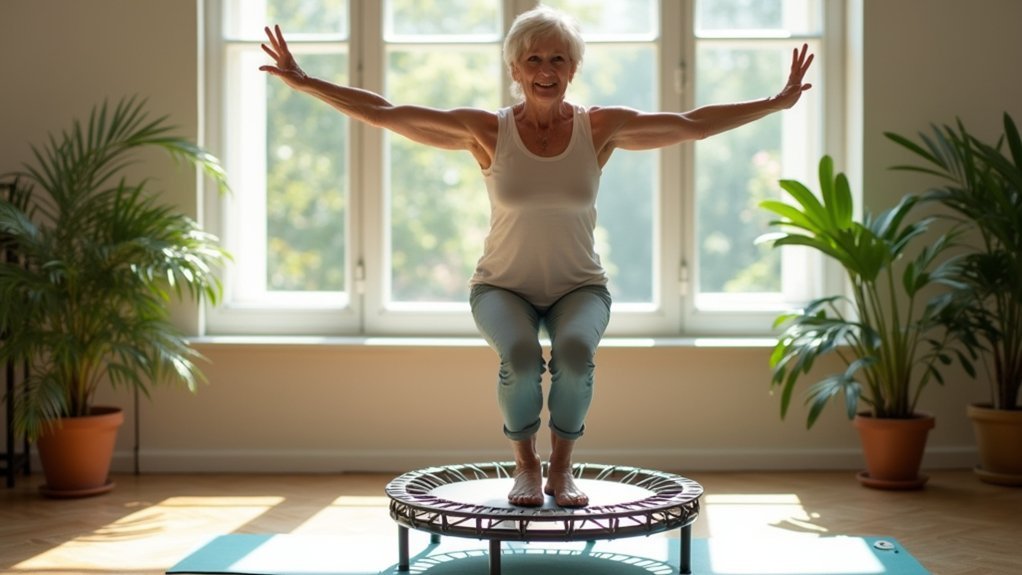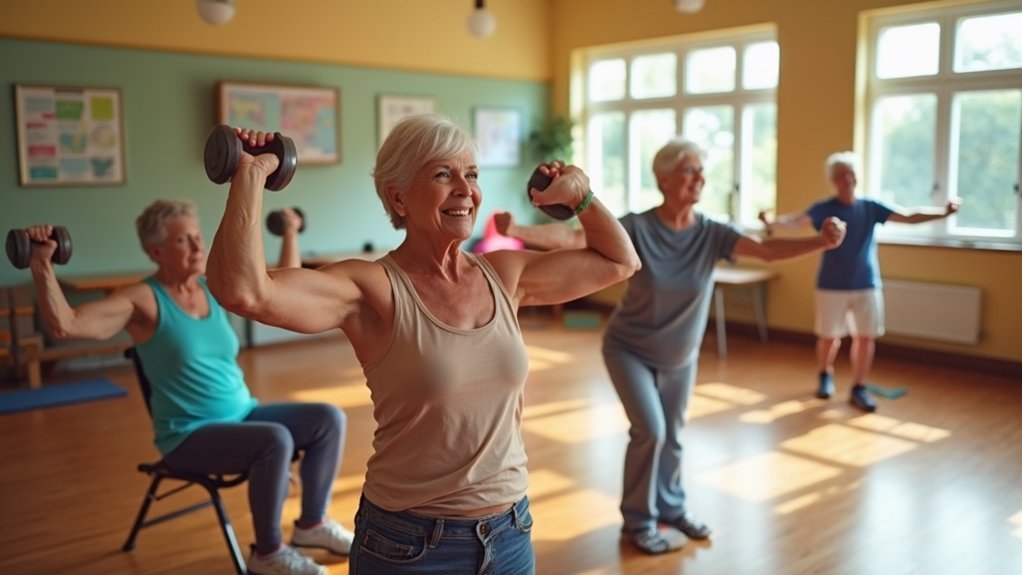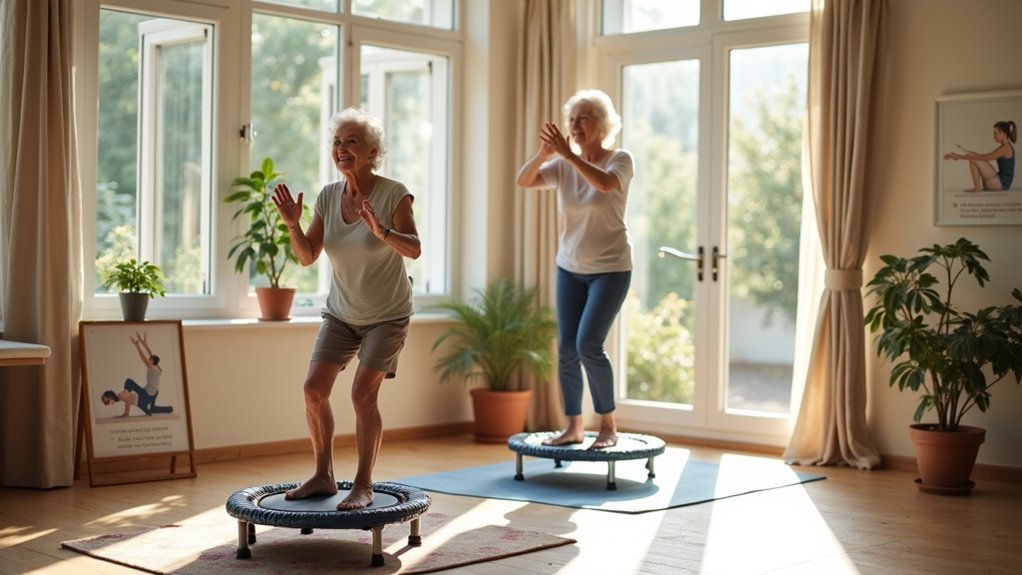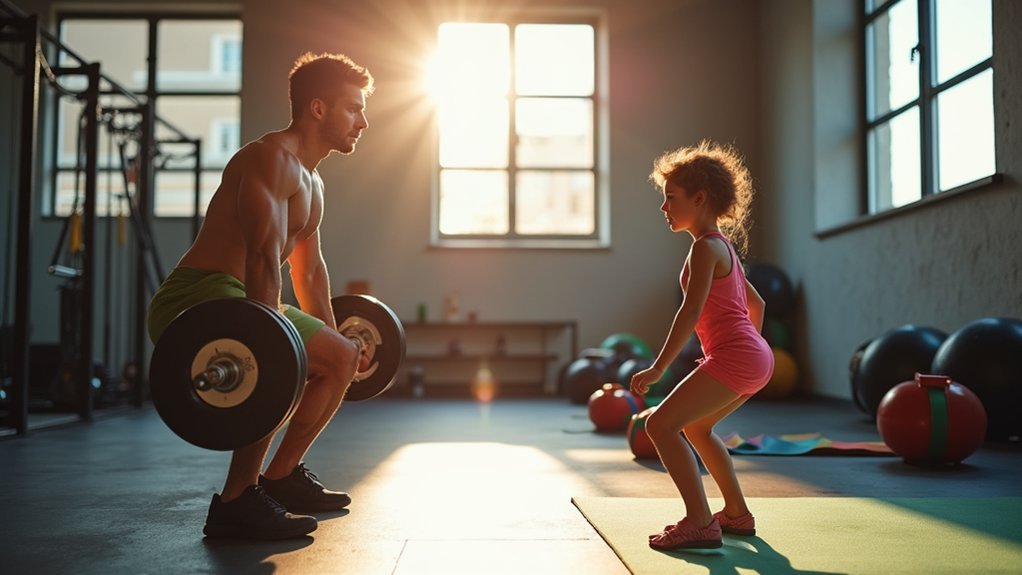Boost your bone health with these five senior-friendly rebounding exercises: gentle bouncing with core engagement, modified jumping jacks that protect aging joints, weighted arm movements like the milkmaid exercise, directional movements for balance and stability, and cooling-down stretches like Happy Baby Pose. You’ll strengthen bones without stressing joints while improving balance and flexibility. These low-impact exercises offer significant benefits for preventing osteoporosis and maintaining independence as you age.
Gentle Bounce and Core Engagement Techniques

While many seniors shy away from high-impact activities, gentle rebounding offers a safe alternative that strengthens bones without stressing joints. On a quality trampoline like the JumpSport 350 Pro, you’ll experience low-impact aerobic movement that stimulates bone density while protecting your frame.
Start with gentle bouncing, keeping your knees tracking directly over your toes to maintain proper alignment. As you bounce, engage your core muscles to enhance stability and balance—key factors in preventing falls.
Gentle bouncing with proper knee alignment creates the foundation for safer rebounding while core engagement prevents falls.
Try incorporating the milkmaid arm movement by raising and lowering your arms rhythmically while maintaining core control.
Remember to breathe intentionally during your rebounding session. This mindful approach not only promotes relaxation but also deepens your core engagement, creating a foundation for better overall body stability.
Modified Jumping Jacks for Joint-Friendly Movement
Traditional jumping jacks can strain aging joints, but modified versions offer seniors all the bone-strengthening benefits without the harsh impact.
You’ll find these modified jumping jacks particularly effective using a directional approach. Think of a clock face as you exercise. Keep one leg stationary while moving the other forward (12 o’clock), to the side (3 o’clock), and back (6 o’clock). This technique minimizes joint stress while enhancing coordination.
Start without weights, focusing on proper form—always keeping knees aligned with toes. Once comfortable, add light hand weights for increased resistance and greater bone-density benefits.
Regular practice of these joint-friendly movements contributes greatly to your bone health and overall strength. The controlled motion allows you to build fitness safely while protecting your aging joints.
Weighted Arm Exercises for Upper Body Strength

Three key weighted movements can transform your rebounding routine into a powerful bone-building workout. The milkmaid arm exercise engages your core and upper body simultaneously, enhancing stability while providing effective resistance training.
These weighted arm exercises not only strengthen your bones but also increase muscle mass, which is vital for preventing osteoporosis. Start with lighter weights to maintain proper form and gradually increase as you build strength.
While rebounding, incorporate dynamic arm movements to improve balance and coordination—essential skills for reducing fall risk. You’ll notice improved functional fitness that translates to better performance in daily activities.
Directional Movements to Enhance Balance and Stability
Moving beyond arm strength, directional movements on your rebounder offer a powerful way to enhance your balance and stability—two capabilities that often decline with age.
Try performing jumping jacks in front, side, and back orientations to challenge your coordination from multiple angles.
Incorporate twisting movements while rebounding to strengthen your core and improve your body’s ability to stabilize during rotation.
Single-time jacks, where one leg stays planted while the other moves, develop unilateral strength that translates to better everyday stability.
Visualize a clock face beneath you and aim your movements toward different “hours” to improve spatial awareness.
These directional movements stimulate your vestibular system—crucial for preventing falls and maintaining independence as you age.
Cool-Down Stretches to Maximize Bone Health Benefits

A proper cool-down routine is just as essential as your rebounding workout for maximizing bone health benefits.
These gentle cool-down stretches help your body shift while supporting long-term bone strength and flexibility.
- Happy Baby Pose – Lie on your back and hold your feet while gently opening your hips. This relaxing position promotes hip mobility vital for maintaining healthy bones.
- Tick-Tock Knees – While lying flat, slowly move your knees from side to side to enhance spinal flexibility and reduce stiffness that can impact bone health.
- Knees to Chest – Pull your knees toward your chest to stretch your lower back and pelvis, improving posture and supporting bone integrity.
Remember to incorporate deep breathing throughout these stretches to reduce stress and promote overall well-being, which indirectly supports your bone health journey.
Frequently Asked Questions
Does Rebounding Improve Bone Density?
Yes, rebounding improves bone density. When you jump on a trampoline, you’re creating impact forces that stimulate bone remodeling. Your bones respond to this regular stress by becoming stronger and denser over time.
Can a 70 Year Old Use a Rebounder?
Yes, you can absolutely use a rebounder at 70. It’s a joint-friendly exercise that strengthens bones, improves balance, and enhances circulation. Start gently and consult your doctor before beginning this beneficial activity.
What Is the Best Exercise on a Trampoline for Osteoporosis?
For osteoporosis, gentle bouncing with controlled knee bends is your best trampoline exercise. You’ll strengthen bones without jarring impacts. Add arm movements while maintaining balance to maximize the bone-building benefits you’ll receive.
What Is the Best Exercise to Increase Bone Density?
Weight-bearing exercises are your best option for increasing bone density. You’ll build stronger bones through walking, jogging, resistance training, and dancing. These activities stimulate bone formation by applying healthy stress to your skeleton.
In Summary
You’ve now learned five effective rebounding exercises that can strengthen your bones and improve your overall mobility. By incorporating these low-impact movements into your routine just 10-15 minutes daily, you’ll boost bone density while protecting your joints. Remember to start slowly, listen to your body, and gradually increase intensity. Your bones will thank you for this enjoyable and effective form of exercise!




Leave a Reply